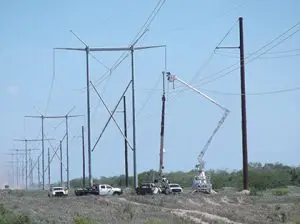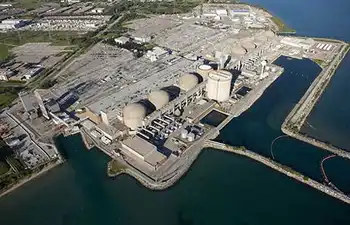OPG learns lesson on restarting Pickering A reactor
TORONTO, ONTARIO - Getting a billion-dollar nuclear project up and running is complicated enough.
Doing it in a Canadian winter can drive you crazy.
A red sun is just lifting over the eastern horizon as nearly 50 construction bosses and engineers gather in a prefabricated office at the Pickering A nuclear station.
This is called the PIT meeting, shorthand for Project Integration Team. It is in charge of restarting a second unit of the Pickering A station idled since 1997.
The first unit to restart, Unit 4, returned to commercial service in September 2003. In July, Energy Minister Dwight Duncan told OPG to fire up Unit 1.
This regular 7 a.m. meeting is held to review the progress of the night shift and report on anticipated problems or successes for the coming day.
The room falls quiet on the dot of 7, and Dean Munsey's Alabama drawl commands from the head of the table. Munsey is assistant director of construction. Seated beside him is his boss, Terry Murphy.
Lining both sides of a long table are two dozen representatives of major contractors and Ontario Power Generation, Pickering's owner and operator. Another 20 or more sit in chairs along the walls.
But the first item on the agenda is not nuclear physics, or a tricky piece of construction engineering. It's winter.
The day's safety report features incidents of workers falling on the roads and sidewalks, turned suddenly icy by the thaw and flash freeze early in the week. A number of workers have been hurt — luckily, none seriously — and attention must be turned briefly to the mundane subject of clearing ice.
It doesn't stay there long.
PIT manager Tom Chiles takes over the meeting at the Action Board, a marker board listing several dozen work areas that are behind schedule and threatening to delay the project, and updates the status of each. Most will be resolved by day's end.
Since the project began, more than 1,200 items have moved on and off the board.
Now it's Munsey's turn.
He opens a binder with the bulk of the day's agenda: 141 pages of reports, each page listing the status of a dozen tasks. The meeting will review every page.
Tasks that seem behind schedule, or have a history of problems, draw comment.
"Let's keep our answers crisp and try to move through this thing quickly," says Munsey.
He grumbles a bit about work that has been completed but not quickly reported as such.
"If it completes on the night shift, I want to know in here in the morning so I can tee up the next job," he tells the group.
A few minutes later, vice-president Bill Robinson demands answers when it's found three valves haven't arrived for installation.
"We were told all three of those would be done today. What happened?" he demands. He is promised an answer, quickly.
By 8 a.m., attention has turned to a conventional water line that has broken, flooding some work areas. Mopping up is taking longer than expected.
"Come on guys, we expected to be back in there this morning," Munsey cajoles.
A few minutes later, it's the turn of his boss Terry Murphy to question why an inspection has found some sub-standard welds that have to be done over.
"They were supposed to be done a week ago," Murphy says. "How in hell can you mess that up? You've got professional welders in there.
But the comments aren't all acid. And most questions have ready answers.
When work seems in danger of slipping, Munsey almost invariably reminds the room that support is available:
"If you need help, be sure and holler."
To an outsider, discussion of the work is largely a jumble of project shorthand and engineering detail. And the detail is staggering.
It involves installing 2.8 million parts, 204 kilometres of electrical cable and 26 kilometres of pipe.
Workers clamber up and down 6 kilometres of scaffolding ladders as they go about the job.
The project is broken into 14 sub-projects, which are further broken down into sub-units, until there are 20,000 actual "work packages."
Those are specific tasks given to a worker or a team, all carefully plotted and sequenced.
The PIT meeting is the ultimate accountability forum.
Hanging over the proceedings is an invisible presence: the ghost of the disastrous restart of the Unit 4 reactor. By the time it came into service in September 2003, it was years behind schedule and $1 billion over budget.
It was a textbook case on how not to manage a big project.
The scope of the work wasn't properly charted or costed at the outset. Planning was sketchy. Crews arrived at the plant to discover plans didn't correspond with equipment.
Engineering work had to be redone, causing massive delays.
Moreover, the project managers failed to do the crucial documentation demanded by nuclear safety regulators. The work must not only be done and inspected, the completion must be recorded and filed.
That documentation didn't keep up with the pace of work in the Unit 4 project. And records were poorly tracked as they passed from work crew to work crew in the sprawling plant.
"It was like a snipe hunt" to find documents, says Murphy.
Now the binders detailing the work packages are housed in their own building, each with a bar code on the cover. When workers take binders to the site, the documents are scanned, their location always known.
The PIT meeting breaks up shortly before 9 a.m. As the participants head for their worksites, they all know they'll be back to do it all over at 5 p.m.
"It's not the time to relax," says Murphy. "We need every hour and every shift to count."
The province has yet to decide if it will restart the still-idle Units 2 and 3 at Pickering. But OPG has promised Unit 1 will be ready for start-up by mid-July, and for commercial operation by mid-October. The deadline weighs on Murphy.
"We have a commitment to the board of directors and to the public that I sure as hell don't want to work this hard and fail to meet."
One wall of the PIT room is papered with graphs charting the project's progress.
That's a huge change from the Unit 4 restart project, says Robinson, who took over after it had run into serious trouble.
"When I took over Unit 4, the only cost control tool I had was a monthly cost report that told me what had happened a month and a half earlier."
Now there are weekly reports. Data shows the project 85 per cent complete, with spending slightly ahead of budget.
"We don't see anything right now standing in the way of us meeting our targets" for getting the reactor restarted, he said.
Related News

US Grid Gets an Overhaul for Renewables
WASHINGTON - The US took a significant step towards a cleaner energy future on May 13th, 2024. The Federal Energy Regulatory Commission (FERC) approved the first major update to the country's electric transmission policy in over a decade. This overhaul aims to streamline the process of building new power lines, specifically those that connect different regions. This improved connectivity is crucial for integrating more renewable energy sources like wind and solar into the national grid.
The current system faces challenges in handling the influx of renewables. Renewable energy sources are variable by nature – the sun doesn't always shine, and…




